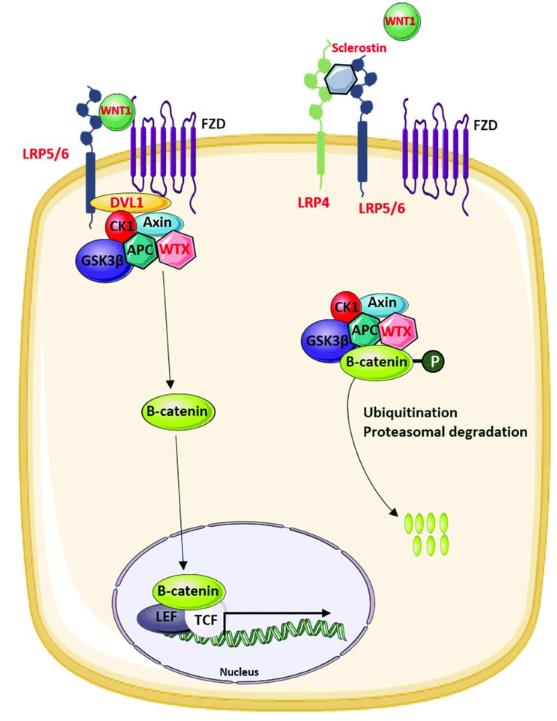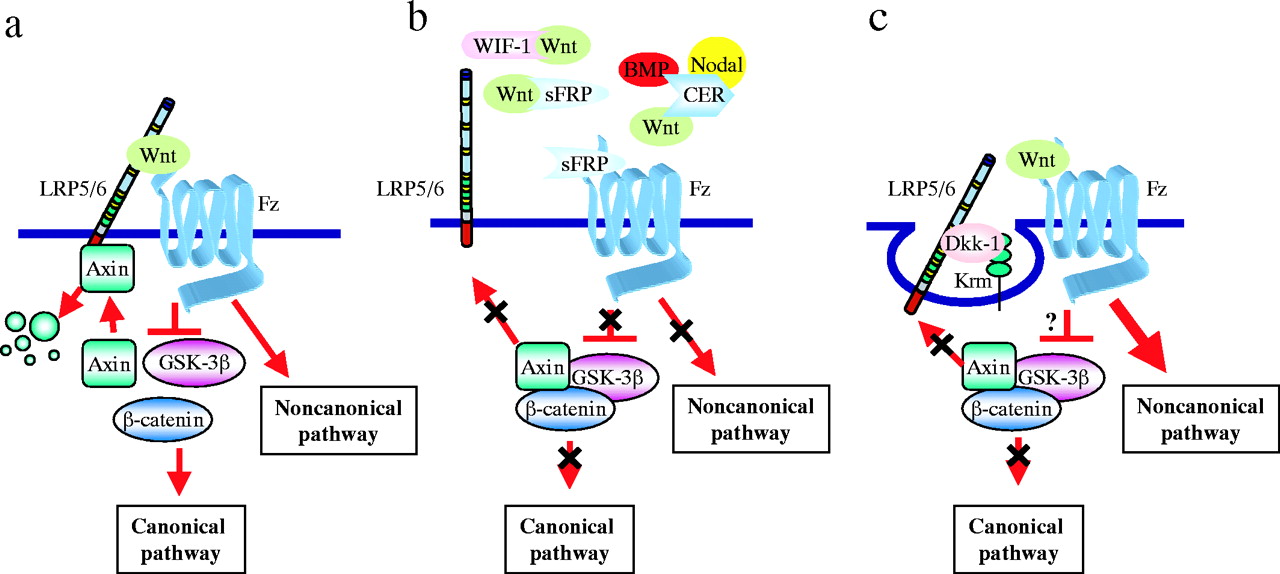Wnt Signaling Modulators
Related Symbol Search List
- RSPO2
- BGN
- DAB2
- Gpc2
- GPC3
- GPC6
- KREMEN1
- LEF1
- MYOC
- NDP
- NEUROD1
- RSPO1
- RSPO3
- RSPO4
- SDC1
- Syndecan-2
- SDC3
- SDC4
- SHISA4
- TSPAN12
Immunology Background
Available Resources for Wnt Signaling Modulators Research
At Creative BioMart you can find a wide range of products related to Wnt signaling modulators, including recombinant proteins and other key products. In addition, we offer customized services to meet your specific requirements, ensuring you get the product you need.
In addition to our products and services, we offer a wealth of resources for your reference. Our resources cover all aspects of Wnt signaling modulators, including the involved pathways, protein function, interacting proteins, related articles, research areas, and other relevant topics. These resources will be invaluable to researchers wishing to deepen their understanding of Wnt signaling modulators and their role in physiological processes.
Our Featured Products
About Wnt Signaling Modulators
Wnt signaling modulators are a diverse group of proteins that regulate the activity and output of the Wnt signaling pathway. These modulators can either enhance (agonists) or inhibit (antagonists) Wnt signaling, fine-tuning the cellular response to Wnt ligands. Here's an introduction to some key Wnt signaling modulators:
Wnt Agonists
- R-spondins (RSPO): R-spondins are secreted proteins that enhance Wnt signaling by binding to LGR4-6 receptors and inhibiting the activity of the transmembrane E3 ubiquitin ligases RNF43 and ZNRF3. These ligases normally target the Wnt co-receptors LRP5/6 for degradation, so RSPOs indirectly promote Wnt pathway activation by preventing LRP5/6 degradation.
- Norrin: Norrin is another secreted protein that activates Wnt signaling, particularly in the context of retinal and vascular development. Norrin binds to FZD4 and the co-receptor LRP5/6, promoting the activation of downstream Wnt signaling events.
Wnt Antagonists
- Dickkopf (DKK) proteins: DKK proteins are secreted antagonists of Wnt signaling. They bind to LRP5/6 and prevent their interaction with Wnt ligands, thereby inhibiting the activation of downstream signaling events.
- Secreted Frizzled-Related Proteins (sFRPs): sFRPs are a family of secreted proteins that can bind directly to Wnt ligands, preventing their interaction with FZD receptors and inhibiting Wnt signaling. sFRPs also can bind to other Wnt pathway components, such as LRP5/6, further inhibiting Wnt signaling.
- Wnt Inhibitory Factor 1 (WIF-1): WIF-1 is a secreted protein that binds directly to Wnt ligands and inhibits their interaction with FZD receptors, thereby preventing Wnt signaling activation.
- Cerberus: Cerberus is a secreted protein that can inhibit Wnt signaling by binding to both Wnt ligands and FZD receptors, disrupting their interaction and inhibiting downstream signaling events.
Other Modulators
- Axin: Axin is a scaffolding protein that plays a crucial role in regulating the activity of the destruction complex, a key component of the canonical Wnt/β-catenin pathway. Axin promotes the degradation of β-catenin by facilitating its phosphorylation and subsequent ubiquitination. Axin levels and activity can modulate the strength of Wnt signaling.
- Naked Cuticle (Nkd): Nkd proteins are intracellular negative regulators of Wnt signaling. They interact with Dishevelled (Dvl), an intracellular component of the Wnt pathway, and promote the degradation of Dvl, thereby inhibiting Wnt signaling.
These are just a few examples of Wnt signaling modulators, and many more have been identified. The precise balance and interplay between agonists and antagonists determine the strength, duration, and specificity of Wnt signaling in different cellular contexts. Dysregulation of these modulators can lead to developmental abnormalities, cancer, and other diseases. The study of Wnt signaling modulators is crucial for understanding the complex regulation and fine-tuning of Wnt signaling pathways.
 Fig.1 Overview of the modulators of the canonical WNT signaling pathway that are involved in the regulation of bone mass in human disease. (Huybrechts Y, et al., 2020)
Fig.1 Overview of the modulators of the canonical WNT signaling pathway that are involved in the regulation of bone mass in human disease. (Huybrechts Y, et al., 2020)
Mechanisms of Action of Wnt Signaling Modulators
Wnt signaling modulators exert their effects on the Wnt signaling pathway through various mechanisms. Here are some common mechanisms of action for Wnt signaling modulators:
Binding to Wnt Ligands
- Antagonists: Wnt antagonists, such as DKK proteins, sFRPs, WIF-1, and Cerberus, directly bind to Wnt ligands. By binding to Wnt ligands, they prevent the interaction between Wnt ligands and their receptors, such as FZD receptors, thereby inhibiting Wnt signaling activation.
- Agonists: Some agonists, like R-spondins and Norrin, can also bind to Wnt ligands. However, their binding enhances Wnt signaling by blocking the activity of negative regulators. For example, R-spondins bind to LGR4-6 receptors and inhibit the E3 ubiquitin ligases RNF43 and ZNRF3, which normally target the Wnt co-receptors LRP5/6 for degradation. This leads to increased availability of LRP5/6, promoting Wnt signaling.
Interacting with Receptors and Co-receptors
- Antagonists: Wnt antagonists can directly interact with FZD receptors and/or co-receptors, such as LRP5/6, preventing their activation or disrupting the formation of functional receptor complexes. This prevents the initiation of downstream signaling events. For instance, DKK proteins bind to LRP5/6 and interfere with their interaction with Wnt ligands.
- Agonists: Some agonists, like Norrin, bind to specific receptors, such as FZD4, and co-receptors, such as LRP5/6, to promote the activation of downstream Wnt signaling events.
Modulating Intracellular Components
Some modulators can interact with intracellular components of the Wnt pathway to regulate its activity:
- Axin: Axin is a key intracellular component involved in the destruction complex, which regulates the canonical Wnt/β-catenin pathway. Axin can be modulated by various mechanisms, including phosphorylation and protein-protein interactions. Changes in Axin levels or activity can influence the stability and degradation of β-catenin, thereby affecting the strength of Wnt signaling.
- Naked Cuticle (Nkd): Nkd proteins interact with Dishevelled (Dvl), an intracellular component of the Wnt pathway. Nkd promotes the degradation of Dvl, inhibiting its function in Wnt signal transduction.
Regulating Extracellular Matrix and Signaling Microenvironment
Some Wnt signaling modulators, such as sFRPs, have been shown to bind to components of the extracellular matrix (ECM) or interact with other signaling molecules. Through these interactions, they can influence the distribution, availability, and presentation of Wnt ligands or receptors, impacting the overall signaling microenvironment.
It's important to note that the mechanisms of action of Wnt signaling modulators can be context-dependent and may vary depending on the specific modulator, the cellular context, and the Wnt signaling pathway being regulated (canonical or non-canonical). The interplay between agonists and antagonists, along with their interactions with receptors and intracellular components, collectively contribute to the fine-tuning and regulation of Wnt signaling outputs in development, homeostasis, and disease.
 Fig.2 Regulation of Wnt signalling by antagonists. (Kawano Y, et al., 2003)
Fig.2 Regulation of Wnt signalling by antagonists. (Kawano Y, et al., 2003)
(a) Activation of the canonical pathway is initiated when Wnt associates with Frizzled (Fz) and LRP5/6. Subsequent events include the recruitment of Axin to LRP5/6 and its degradation, and the phosphorylation of dishevelled, resulting in disruption of the link between β-catenin and GSK-3β. β-catenin is no longer phosphorylated and is thus stabilised. Activation of the noncanonical pathway may involve interaction of Wnt with Fz in the absence of LRP5/6. (b)Antagonists such as sFRPs, Cerberus (CER) and WIF-1 prevent Wnt from binding to its receptors. In this case, both the canonical and the noncanonical pathways are inactivated. sFRPs may also inhibit Wnt by binding to Frizzled. (c) Dkk-1 interacts with LRP5/6 and the co-receptor Kremen 1/2 (Krm, green),and this triggers LRP5/6 endocytosis, thereby preventing formation of the LRP5/6–Wnt–Frizzled complex. Axin brings together the proteins that promote β-catenin phosphorylation, enabling β-catenin degradation and inhibition of the canonical pathway. The Wnt-Fz complex can still activate the noncanonical pathway.
If you have any questions, requirements, or cooperation intentions, please feel free to contact us. We very much look forward to working with you and helping you achieve research and commercial success.
References:
- Blagodatski A, Klimenko A, Jia L, Katanaev VL. Small Molecule Wnt Pathway Modulators from Natural Sources: History, State of the Art and Perspectives. Cells. 2020;9(3):589. Published 2020 Mar 2. doi:10.3390/cells9030589
- Huybrechts Y, Mortier G, Boudin E, Van Hul W. WNT Signaling and Bone: Lessons From Skeletal Dysplasias and Disorders. Front Endocrinol (Lausanne). 2020;11:165. Published 2020 Apr 9. doi:10.3389/fendo.2020.00165
- Kawano Y, Kypta R. Secreted antagonists of the Wnt signalling pathway. J Cell Sci. 2003;116(Pt 13):2627-2634. doi:10.1242/jcs.00623

